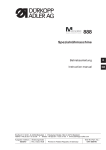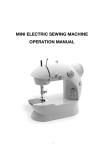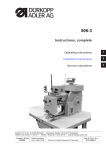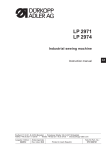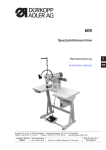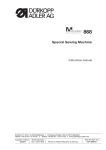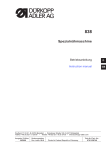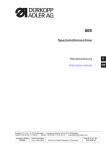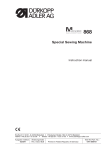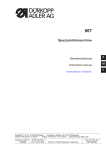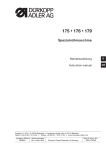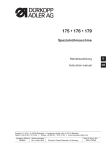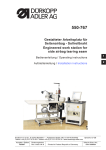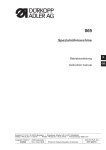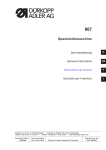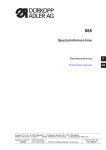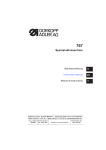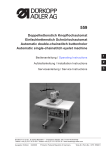Download Operating Instructions
Transcript
868 Spezialnähmaschine Betriebsanleitung Instruction manual Postfach 17 03 51, D-33703 Bielefeld • Potsdamer Straße 190, D-33719 Bielefeld Telefon +49 (0) 521 / 9 25-00 • Telefax +49 (0) 521 / 9 25 24 35 • www.duerkopp-adler.com Ausgabe / Edition: 05/2008 Änderungsindex Rev. index: 00.0 Printed in Federal Republic of Germany Teile-Nr./Part.-No.: 0791 868740 D GB Alle Rechte vorbehalten. Eigentum der Dürkopp Adler AG und urheberrechtlich geschützt. Jede, auch auszugsweise Wiederverwendung dieser Inhalte ist ohne vorheriges schriftliches Einverständnis der Dürkopp Adler AG verboten. All rights reserved. Property of Dürkopp Adler AG and copyrighted. Reproduction or publication of the content in any manner, even in extracts, without prior written permission of Dürkopp Adler AG, is prohibited. Copyright © Dürkopp Adler AG - 2008 Foreword This instruction manual is intended to help the user to become familiar with the machine and take advantage of its application possibilities in accordance with the recommendations. The instruction manual contains important information on how to operate the machine securely, properly and economically. Observation of the instructions eliminates danger, reduces costs for repair and down-times, and increases the reliability and life of the machine. The instruction manual is intended to complement existing national accident prevention and environment protection regulations. The instruction manual must always be available at the machine/sewing unit. The instruction manual must be read and applied by any person that is authorized to work on the machine/sewing unit. This means: – – – Operation, including equipping, troubleshooting during the work cycle, removing of fabric waste, Service (maintenance, inspection, repair) and/or Transport. The user also has to assure that only authorized personnel work on the machine. The user is obliged to check the machine at least once per shift for apparent damages and to immediatly report any changes (including the performance in service), which impair the safety. The user company must ensure that the machine is only operated in perfect working order. Never remove or disable any safety devices. If safety devices need to be removed for equipping, repairing or maintaining, the safety devices must be remounted directly after completion of the maintenance and repair work. Unauthorized modification of the machine rules out liability of the manufacturer for damage resulting from this. Observe all safety and danger recommendations on the machine/unit! The yellow-and-black striped surfaces designate permanend danger areas, eg danger of squashing, cutting, shearing or collision. Besides the recommendations in this instruction manual also observe the general safety and accident prevention regulations! General safety instructions The non-observance of the following safety instructions can cause bodily injuries or damages to the machine. 1. The machine must only be commissioned in full knowledge of the instruction book and operated by persons with appropriate training. 2. Before putting into service also read the safety rules and instructions of the motor supplier. 3. The machine must be used only for the purpose intended. Use of the machine without the safety devices is not permitted. Observe all the relevant safety regulations. 4. When gauge parts are exchanged (e.g. needle, presser foot, needle plate, feed dog and bobbin) when threading, when the workplace is left, and during service work, the machine must be disconnected from the mains by switching off the master switch or disconnecting the mains plug. 5. Daily servicing work must be carried out only by appropriately trained persons. 6. Repairs, conversion and special maintenance work must only be carried out by technicians or persons with appropriate training. 7. For service or repair work on pneumatic systems, disconnect the machine from the compressed air supply system (max. 7-10 bar). Before disconnecting, reduce the pressure of the maintenance unit. Exceptions to this are only adjustments and functions checks made by appropriately trained technicians. 8. Work on the electrical equipment must be carried out only by electricians or appropriately trained persons. 9. Work on parts and systems under electric current is not permitted, except as specified in regulations DIN VDE 0105. 10. Conversion or changes to the machine must be authorized by us and made only in adherence to all safety regulations. 11. For repairs, only replacement parts approved by us must be used. 12. Commissioning of the sewing head is prohibited until such time as the entire sewing unit is found to comply with EC directives. 13. The line cord should be equipped with a country-specific mains plug. This work must be carried out by appropriately trained technicians (see paragraph 8). It is absolutely necessary to respect the safety instructions marked by these signs. Danger of bodily injuries ! Please note also the general safety instructions. Contents Page: Preface and general safety instructions Part 1: Operating Instructions Class 868 (Edition 05/2008) 1. Product description . . . . . . . . . . . . . . . . . . . . . . . . . . . . . . . . . . . . . . . . . . . . 5 2. Designated use . . . . . . . . . . . . . . . . . . . . . . . . . . . . . . . . . . . . . . . . . . . . . . . 5 3. Subclasses . . . . . . . . . . . . . . . . . . . . . . . . . . . . . . . . . . . . . . . . . . . . . . . . . . 6 4. Optional equipment. . . . . . . . . . . . . . . . . . . . . . . . . . . . . . . . . . . . . . . . . . . . . 8 5. 5.1 Technical data . . . . . . . . . . . . . . . . . . . . . . . . . . . . . . . . . . . . . . . . . . . . . . . . Technical data subclasses . . . . . . . . . . . . . . . . . . . . . . . . . . . . . . . . . . . . . . . . . 10 11 6. 6.1 6.2 6.2.1 . . . . . . . . 13 15 . . . . . . . . 16 16 6.3 6.4 6.4.1 6.4.2 6.4.3 6.5 6.6 6.7 6.8 6.9 6.10 6.11 6.12 6.13 6.14 6.15 6.16 6.17 Operation Threading the needle thread . . . . . . . . . . . . . . . . . . . . . . . . . . . . . . . . . . . . Adjusting the needle-thread tension . . . . . . . . . . . . . . . . . . . . . . . . . . . . . . . Function of the thread main tension and the thread supplementary tension in relation to the sewing foot lifting . . . . . . . . . . . . . . . . . . . . . . . . . . . . . . . . . . . . . . . Reparation seam with thread tension always closed . . . . . . . . . . . . . . . . . . . . . . Function of the thread’s supplementary tension in relation to the stroke adjustment and the Speedomat. . . . . . . . . . . . . . . . . . . . . . . . . . . . . . . . . . . . . . . . . . Opening the thread tension . . . . . . . . . . . . . . . . . . . . . . . . . . . . . . . . . . . . . Short stitch . . . . . . . . . . . . . . . . . . . . . . . . . . . . . . . . . . . . . . . . . . . . . . Short stitch at the seam beginning . . . . . . . . . . . . . . . . . . . . . . . . . . . . . . . . Short stitch at the end of a seam . . . . . . . . . . . . . . . . . . . . . . . . . . . . . . . . . Short stitch at the seam beginning and seam end . . . . . . . . . . . . . . . . . . . . . . . Switching the supplementary tension on and off with machines without thread trimmer . Adjusting the thread regulator . . . . . . . . . . . . . . . . . . . . . . . . . . . . . . . . . . . Winding on the hook thread. . . . . . . . . . . . . . . . . . . . . . . . . . . . . . . . . . . . . Changing the hook-thread bobbin . . . . . . . . . . . . . . . . . . . . . . . . . . . . . . . . . Setting the hook thread tension . . . . . . . . . . . . . . . . . . . . . . . . . . . . . . . . . . Inserting and changing the needle with single-needle machines . . . . . . . . . . . . . . Inserting and changing the needle with double-needle machines . . . . . . . . . . . . . . Lifting the sewing foot . . . . . . . . . . . . . . . . . . . . . . . . . . . . . . . . . . . . . . . . Locking the sewing feet in lifted position . . . . . . . . . . . . . . . . . . . . . . . . . . . . . Sewing-foot pressure . . . . . . . . . . . . . . . . . . . . . . . . . . . . . . . . . . . . . . . . Sewing-foot stroke . . . . . . . . . . . . . . . . . . . . . . . . . . . . . . . . . . . . . . . . . . Setting the stitch length . . . . . . . . . . . . . . . . . . . . . . . . . . . . . . . . . . . . . . . Key pad on the machine arm . . . . . . . . . . . . . . . . . . . . . . . . . . . . . . . . . . . . . . . . . . . . . . . . . . . . . . . . . . . . . . . . . . . . . . . . . . 17 17 18 18 18 18 19 20 21 22 23 24 25 26 27 27 28 30 31 7. Sewing drive and operating panel . . . . . . . . . . . . . . . . . . . . . . . . . . . . . . . . . . . 32 8. Sewing . . . . . . . . . . . . . . . . . . . . . . . . . . . . . . . . . . . . . . . . . . . . . . . . . . . . . 33 6.2.2 6.2.3 . . . . . . . . . . . . . . . . . . . . . . . . . . . . . . . . . . . . . . GB Contents Page: 9. 9.1 9.2 Maintenance Cleaning and testing . . . . . . . . . . . . . . . . . . . . . . . . . . . . . . . . . . . . . . . . . . . . . Lubrication . . . . . . . . . . . . . . . . . . . . . . . . . . . . . . . . . . . . . . . . . . . . . . . . . . . 35 37 10. 10.1 Optional equipment Seam center guide . . . . . . . . . . . . . . . . . . . . . . . . . . . . . . . . . . . . . . . . . . . . . . 38 1. Product description The DÜRKOPP ADLER 868 is a special sewing machine for universal use. · · · · · · · 2. It is a flatbed double-lockstitch machine with bottom feed, needle feed and alternating upper foot feed. Depending on the subclass it comes as single or double needle automat, with or without electromagnetic thread cutter, with or without edge trimmer. Equipped with a large or oversized two-piece vertical hook. With a maximum of 20 mm fabric clearance when sewing feet are lifted. A safety clutch prevents a changing of the hook setting or a hook damage in the case of a thread deflection into the shuttle track. Automatic wick lubricating with an inspection glass on the arm for machine and hook lubrication. Integrated winder. GB Designated use The 868 class is a sewing machine designed for sewing light to medium-heavy material. Such material is generally made of textile fibers, but it may also be leather. It is used in the clothing industry and for domestic and motor-vehicle upholstery. This special sewing machine can also be used to produce so-called technical seams. In this case, however, the operator must assess the possible dangers which may arise (with which DÜRKOPP ADLER AG would be happy to assist), since such applications are on the one hand relatively unusual and, on the other, so varied that no single set of criteria can cover them all. The outcome of this assessment may require appropriate safety measures to be taken. Generally only dry material may be sewn with this machine. The material may be no thicker than 10 mm when compressed by the lowered sewing feet. The material may not contain any hard objects, since if it does the machine may not be operated without an eye-protection device. No such device is currently available. The seam is generally produced with textile-fibre sewing thread of gauge up to 11/3 NeB (cotton), 11/3 Nm (synthetic) or 11/4 Nm (covering yarn). Before using any other thread the possible dangers arising must be assessed and appropriate safety measures taken if necessary. 5 This special sewing machine may be set up and operated only in dry, well-maintained premises. If the sewing machine is used in premises which are not dry and well-maintained it may be necessary to take further precautions, which should be agreed upon in advance (see EN 60204-31:1999). As manufacturers of industrial sewing machines we proceed on the assumption that personnel who work on our products will have received training at least sufficient to acquaint them with all normal operations and with any hazards which these may involve. 3. 6 Subclasses 868-190020 Single-needle double-lockstitch post bed machine with bottom feed, needle feed, alternating upper foot feed and large hook. 867-290020 Double-needle double-lockstitch post bed machine with bottom feed, needle feed, alternating upper foot feed and large hook. 868-190322 Single-needle double-lockstitch post bed machine with bottom feed, needle feed, alternating upper foot feed, electro-pneumatic rapid stroke adjustment with automatic speed limitation, operated via knee lever, electro-magnetic thread cutter, electro-pneumatic seam bartacking, electro-pneumatic second stitch length and sewing foot lifting. With large hook, with integrated sewing lamp. Function keys for: manually sewing backward, needle high/low /single stitch, switching on/off of the bartack, 2nd stitch length, switching on/off of the supplementary thread tension . 868-290322 Double-needle double-lockstitch post bed machine with bottom feed, needle feed, alternating upper foot feed, electro-pneumatic rapid stroke adjustment with automatic speed limitation, operated via knee lever, electro-magnetic thread cutter, electro-pneumatic seam bartacking, electro-pneumatic second stitch length and sewing foot lifting. With large hook, with integrated sewing lamp. Function keys for: manually sewing backward, needle high/low /single stitch, switching on/off of the bartack, 2nd stitch length, switching on/off of the supplementary thread tension. 868-390322 Double-needle double-lockstitch post bed machine with bottom feed, needle feed, alternating upper foot feed, electro-pneumatic rapid stroke adjustment with automatic speed limitation, operated via knee lever, electro-magnetic thread cutter, electro-pneumatic seam bartacking, electro-pneumatic second stitch length and sewing foot lifting. With large hook, with integrated sewing lamp. Left post. Function keys for: manually sewing backward, needle high/low /single stitch, switching on/off of the bartack, 2nd stitch length, switching on/off of the supplementary thread tension. GB 7 4. Optional equipments For the 868 the following optional equipments are available: Optional equipment Subclasses 0867 590014 Electro-pneumatic needle cooler from the top 0867 590064 Pneumatic connection x x x x x 9780 000108 WE-8 maintenance unit for pneumatic optional equipments x x o o o 9822 510003 Halogen sewing lamp x x x x x 9880 867100 Sewing lamp add-on kit x x x x x 0798 500088 Sewing lamp transformer x x x x x 9880 867103 Sewing lamp LED x x x x x 9880 867102 Integrated sewing lamp LEDs x x o o o 9850 001089 Power supply complete for integrated sewing lamp LEDs x x o o o N800 080001 Edge guide, swivelling x x N800 080004 Roller stop x x N800 080021 Edge guide, swivelling x x N800 005650 Seam center guide x x N800 005655 Seam center guide, swivelling x x x x 868-190020 868-290020 868-190322 868-290322 868-390322 Order No. No. according Tape guide with tape-reel bracket to the band size 9805 791113 x USB memory key for transferring data with the Efka control unit DA321G x x x x x 0797 003031 Pneumatic connection package x x x x 0867 590354 Pneumatic sewing foot lifting x x MG55 400364 Stand set MG 55-3 for motor fitting beneath the table, with pedal Table top size 1060 x 600 mm x x x x x MG55 400374 Stand set MG 55-3 for motor fixed on machine head, with Pedal Table top size 1060 x 600 mm Stands x = Optional equipment o = Standard equipment 8 x x x Please contact our Application Center (APC) for further optional equipment. E-Mail: [email protected] Further available documents concerning the class 868: 0791 0791 0791 0791 868801 868641 100700 867701 0791 867704 0791 867705 Parts list Service Instructions Fitting Instructions for Sewing Lamp LED Instructions for fitting seam center guide N800 005655 (mechanically) N800 005650 (pneumatically) Instructions for fitting pneumatic sewing foot lift Instructions for fitting for edge guide N800 080021 GB 9 5. Technical data Noise: Workplace-related emission value in accordance with DIN 45635-48-A-1-KL2 868-190020 LC = _dB (A) Stitch length: _ mm Material: Sewing foot stroke: mm Speed: ____ min -1 LC = _dB (A) Stitch length: _ mm Material: Sewing foot stroke: mm Speed: ____ min -1 LC = _dB (A) Stitch length: _ mm Material: Sewing foot stroke: mm Speed: ____ min -1 LC = _dB (A) Stitch length: _ mm Material: Sewing foot stroke: mm Speed: ____ min -1 LC = _dB (A) Stitch length: _ mm Material: Sewing foot stroke: mm Speed: ____ min -1 868-290020 868-190322 868-290322 868-390322 10 868-290322 868-390322 large large 1 2 1 2 Type of stitch 868-290020 large 868-190322 large 868-190020 Technical data subclasses large 5.1 Lockstitch 301 Hook type Number of needles Needle system 1 134-35 Needle size (depending on E-No.) [Nm] Max. thread thickness [Nm] Stitch length - Forward - Backward [mm] GB 170 10 / 3 12 12 Number adj. stitch lengths 1 2 1 2 2 Max. speed [min ] 2500 2500 2500 2500 2500 Speed with factory setting [min ] 2500 2500 2500 2500 2500 20* 20* 20* 20* 20* - 1 - 1 Max. lifting height [mm] (*only with turn-back device) Max. sewing foot stroke [mm] 9 9 9 9 9 Operating pressure [bar] - 6 - 6 6 Air consumption per working cycle [NL] - 0,7 - 0,7 0,7 Dimensions (H x W x D) [mm] Weight with direct drive [kg] 690 / 220 / 640 68 - 68 72 70 - 70 74 68 72 11 Threading scheme single-needle machine 11 1 2 10 3 9 4 8 5 7 6 0868 190xxx 0868 390xxx Threading scheme double-needle machine - 22 12 13 21 14 15 20 19 18 17 12 16 6. 6.1 Operation Threading the needle thread Caution: danger of injury ! Turn off the main switch. The needle thread may only be threaded with the sewing machine switched off. – Put the thread reel on the thread stand and lead the needle thread through the unwinder arm. The unwinder arm must be in vertical position above the thread reels. – Thread in the thread through threading guide 1 and 2. – – Conduct the thread clockwise around the pre-tensioner wheel 3. Conduct the thread counter-clockwise around the supplementary tensioner wheel 4. – Conduct the thread clockwise around the main tensioner wheel 5. – Pull the thread underneath the thread take-up spring 8 and conduct it through the thread regulator 10 to the thread lever 11. – Conduct the thread through the thread lever 11 and the threading guides 9, 7 and 6 on the needle bar. Thread the thread into the needle eye. – GB Threading in the needle thread with double-needle machines – Put the thread reels on the thread stand and lead the needle thread through the unwinder arm. The unwinder arm must be in vertical position above the thread reels. Thread for the left needle (as with single-needle machines) – Thread in the thread through threading guide 1 and 2. – Conduct the thread clockwise around the pre-tensioner 3. – Conduct the thread counter-clockwise around the supplementary tensioner 4. – Conduct the thread clockwise around the main tensioner 5. – – – Pull the thread underneath the thread take-up spring 8 and conduct it through the thread regulator 10 to the thread lever 11. Conduct the tread through the upper bore hole of the thread lever 11 and the threading guides 9, 7 and 6 on the needle bar. Thread the thread into the needle eye. Thread for the right needle – Thread in the thread through threading guide 12 and 13. – Conduct the thread clockwise around the pre-tensioner 14. – Conduct the thread counter-clockwise around the supplementary tensioner 15. – Conduct the thread clockwise around the main tensioner 16. – – – Pull the thread underneath the thread take-up spring 19 and conduct it through the thread regulator 21 to the thread lever 22. Conduct the thread through the lower bore hole of the thread lever 22 and the threading guides 20, 18 and 17 on the needle bar. Thread the thread into the eye of the right needle. 13 3 14 2 1 5 4 Fig. A: Correct thread interlacing in the center of the material Fig. B: Needle-thread tension too low or hook-thread tension too high Fig. C: Needle-thread tension too high or hook-thread tension too low 6.2 Adjusting the needle-thread tension Pre-tensioner When the main tensioner 2 and supplementary tensioner 3 are open (e.g. when the sewing feet are raised) the needle thread must be under slight residual tension. This residual tension is produced by the pre-tensioner 1. The pre-tensioner 1 simultaneously affects the length of the end of the severed needle thread (the starting thread for the next seam). – Basic setting: Turn knurled nut 4 until its front is flush with the bolt 5. – To shorten the starting thread: Turn knurled nut 4 clockwise. – To lengthen the starting thread: Turn knurled nut 4 counterclockwise. Main tensioner The main tensioner 2 should be set to the minimum possible tension. The looping of the threads must be in the center of the material. With thin material excessive thread tension can cause unwanted gathering and thread breakage. – Adjust the main tensioner 2 so that the stitches are uniform. To increase tension: turn the knurled nut clockwise To decrease tension: turn the knurled nut anti-clockwise GB Supplementary tensioner The supplementary tensioner 3 can be switched in to effect a rapid change in needle-thread tension during operation (e.g. with thickened seams). – Set the supplementary tensioner 3 lower than the main tensioner 2. 15 6.2.1 Function of the thread main tension and the thread supplementary tension in relation to the sewing foot lifting Only Efka DC 1550 DA 321G The thread supplementary tension can, at any time, be switched on or off by actuating the switch key 1 (see chapter 6.17) on the key block of the machine. To this end, the parameter F-255 must be set on “7". Parameter Sewing foot lifting Sewing foot lifting withing a seam after thread trimming Thread main tension Thread supplement. tension Thread main tension Thread supplement. tension F-196=0 0 0 0 0 F-196=0 1 1 0 0 F-196=0 0 0 1 1 F-196=0 1 1 1 1 setting 1 = Thread tension opened mechanically 0 = Thread tension closed mechanically · · 6.2.2 If the thread’ s supplementary tension is opened, this condition will be maintained when lifting the sewing foot. When switching the machine off, the last setting of the thread’s supplementary tension will be maintained through the mains connection. Reparation seam with thread tension always closed Only Efka DC 1550 DA 321G When executing a reparation seam, the thread tension is to stay closed during the lifting of the sewing foot. Then the setting of the parameter F-196 for the function of the thread main tension and the thread supplementary tension in relation to the sewing foot lifting is not active. For a quick switching on and off of the reparation seam, a parameter setting first has to be carried out. · · Programming the reparation seam with key “A” of the Efka operating panel V810/V820: Set the parameter F-293 to 18. Programming the reparation seam with the key “B” of the Efka operating panel V810/V820: Set the parameter F-294 to 18. By actuating the key “A” or “B” on the Efka operating panel V810 or V820, the reparation seam, with the thread tension being always closed, can be switched on and off quickly. If the reparation seam mode was switched on, at the end of the reparation seam it has to be switched off by actuating the same key of the Efka operating panel, in order to activate the parameter F-196 again. 16 6.2.3 Function of the thread’s supplementary tension in relation to the stroke adjustment and the Speedomat Only Efka DC 1550 DA 321G The thread’s supplementary tension can, at any time, be switched on and off by actuating the key 1 (see chapter 6.17) of the machine’s keypad. To that end, the parameter F-255 must be set to “7". Parameter Setting F-197 F-197 F-197 F-197 = = = = 0 1 2 3 stroke adjustment max. via knee switch 1 0 1 (*) 0 stroke adjustments setting wheel Reaching of the HP-speed of parameter F-117 (Speedomat) 1 1 0 0 (*) If the stroke adjustment (max. via knee switch is switched on and the HP-speed of parameter F-117 is reached through the “Speedomat”, the thread’s supplementary tension will be switched on automatically. 0 = Thread’s supplementary tension closed mechanically 1 = Thread’s supplementary tension opened mechanically · · GB If the thread’s supplementary tension is closed, the condition will be maintained when adjusting the stroke. When the machine is switched off, the last setting of the thread’s supplementary tension will be maintained through the mains connection. Basic control box setting for the automatic steps of the stitch-number-reduction (Speedomat) through the setting wheel for the height of the alternating transport stroke Parameter 188 Step 01-21 Step 01-10 Step 11-18 Step 19-21 6.3 total Speedomat range max. allowed number of stitches. parameter F-111 = = 2500min -1 linear stepwise reduction of the max. number of stitches (Speedomat) max. allowed number of stitches, parameter F-117 = 1.600 min -1 Opening the thread tension Subclasses 868-190020, 868-290020 When lifting the sewing feet with the knee switch, main and supplementary tension are automatically opened. Subclasses 868-190322, 868-290322, 0868-390322 The thread tension is automatically opened when trimming the thread. 17 6.4 Short stitch The short stitch can be set mechanically forward as well as backward. The short stitch is set by turning the stop screw 2 with an Allen wrench (size 3): Clockwise à forward. Counterclockwise à backward. 6.4.1 Short stitch at the seam beginning When sewing without initial bartack the reliability of the seam beginning can be increased by beginning the seam with a short stitch. The function is switched on by setting the parameter F-136 to “4" while the “Soft-Start” parameter F-134 is set to “1". 6.4.2 Short stitch at the end of a seam At the end of a seam the function “Short Thread trimming” (FA-STL) can be switched on. This function guarantees a safe thread trimming with stitch lengths above 6 mm. The function “Short Thread trimming” is switched on by setting the Parameter F-136 to “2" with the Efka control unit. 6.4.3 Short stitch at the seam beginning and seam end This function is switched on by setting the parameter F-136 to “3" while the ”Soft-Start" parameter F-134 is set to “1". 1 18 1 2 6.5 Switching the supplementary tension on and off with machines without thread trimmer 1 GB 2 The supplementary tension is being switched on and off with lever 1. Switching on – Push the handle 2 of lever 1 to the left. Switching off – Push the handle 2 of the lever 1 to the right. 19 6.6 Adjusting the thread regulator 3 2 1 Caution: danger of injury ! Turn off the main switch. The thread regulator may only be adjusted with the sewing machine switched off. The thread regulator 1 controls the quantity of needle thread required for stitch formation. The thread regulator must be precisely adjusted for an optimum result. At the correct setting the needle-thread loop must slide at low tension over the thickest point of the hook. – Undo screw 2. – Adjust the thread regulator 1. Thread regulator to the left = more thread. Thread regulator to the right = less thread. – Tighten screw 2. Adjustment information: If the maximum quantity of thread is required the thread-tensioning spring 3 must be pulled upwards about 0.5 mm from its lower limit position. This is the case when the needle-thread loop passes the maximum hook diameter. 20 6.7 Winding on the hook thread 5 4 3 2 1 2 6 – Put the thread reel on the thread stand and conduct the needle thread through the unwinder arm. – Conduct the thread through the thread guide 5, around the tensioner 4 and through the thread guide 3. – Place the thread behind the blade 6 and sever it (in the arrow direction). – Fit the bobbin 1 onto the bobbin winder. There is no need to wind the thread onto the bobbin by hand. – – Press the bobbin-winder lever 2 into the bobbin. Sewing The bobbin-winder lever terminates the process as soon as the bobbin is full. The bobbin winder always stops in such a position that the blade 6 is in the insertion position (see right-hand illustration). – Remove the full bobbin 1, place the thread behind the blade 6 and sever it (in the arrow direction). Fit empty bobbin onto the bobbin winder for the next winding process and press the bobbin-winder lever 2 into the bobbin. – GB Caution Danger of breakage! If the thread is not to be wound on during sewing, it is essential for the sewing foot to be locked in the raised position and to set the sewing-foot stroke to its smallest value. 21 6.8 Changing the hook-thread bobbin 1 7 6 5 4 3 2 Caution: danger of injury ! Turn off the main switch. The hook-thread bobbin may only be changed with the machine switched off. Removing the empty bobbin – Raise the sewing foot. – Pull the hook cover 1 upwards and open it. – Lift the flap 5 and remove the empty bobbin 2. Inserting a full bobbin – Insert the full bobbin 2 so that it moves in the opposite direction of the hook when unwinding. – Conduct the hook thread through the slot 3 and underneath the spring 4. – Pull the hook thread through the slot 7 and continue pulling until it stands out about 4.5 cm. – Close the flap 5 and pull the hook thread through the thread guide 6 of the flap. 22 6.9 Setting the hook thread tension 1 2 GB Caution: danger of injury ! Turn off the main switch. The hook-thread tension may only be adjusted with the machine switched off. Setting the tension spring 2 – Set the tension spring 2 by turning the adjustment screw 1. Increase the hook thread tension = Turn screw 1 clockwise Decrease the hook thread tension = Turn screw 1 counterclockwise 23 6.10 Inserting and changing the needle with single-needle machines 1 2 3 2 1 Caution: danger of injury ! Turn off the main switch. The needle may only be changed with the sewing machine switched off. – Turn the hand wheel, until the needle bar 1 has reached its highest position. – Loosen screw 2. – Pull the needle downwards out of the needle bar 1. – Push in the new needle into the hole of the needle bar 1 as far as it will go. Attention! The needle scarf 3 must point towards the hook. – Tighten screw 2. CAUTION! When changing to another needle size, the distance between hook and needle must be readjusted (see service instructions). Ignoring the above mentioned hint can cause the following mistakes: When inserting a thinner needle: – Missed stitches Damage of the thread When inserting a thicker needle: – Damage of the hook tip Damage of the needle 24 6.11 Inserting and changing the needle with double-needle machines 1 2 3 4 GB Caution: danger of injury ! Turn off the main switch. The needle may only be changed with the sewing machine switched off. – Turn the hand wheel until the needle bar 1 has reached its highest position. – Loosen screw 3. – Pull the needle downwards out of the needle holder 2. – Push the new needle into the hole of the needle holder 2 as far as it will go. Attention! Seen from the operating side, the needle scarf 4 of the right needle must point to the right side and the needle scarf of the left needle point to the left side (see drawing). – Tighten screw 3. CAUTION! When changing to another needle size, the distance between hook and needle must be readjusted (see service instructions). Ignoring the above mentioned hint can cause the following mistakes: When inserting a thinner needle: – Missed stitches Damage of the thread When inserting a thicker needle: – Damage of the hook tip Damage of the needle 25 6.12 Lifting the sewing foot 2 1 Subclasses 868-190020, 868-290020 The sewing feet can be lifted mechanically by actuating the knee lever 1. Subclasses 868-190322, 868-290322, 868-390322 The sewing feet can be lifted electro-pneumatically by actuating the pedal 2 or the knee lever 1. Raising the sewing foot mechanically (knee lever) – To adjust the position of the material (e.g. for corrective purposes), push the knee lever 1 to the right. The sewing foot stays in the up position as long as pressure is maintained on the knee lever 1. Raising the sewing foot electro-pneumatically (pedal) – Press the pedal 2 half-way back. The sewing feet are raised with the machine at a halt. – Press the pedal 2 all the way back. The thread is severed and the sewing foot raised. 26 6.13 Locking the sewing feet in lifted position 1 1 – Push the lever 1 downwards. The sewing feet are locked in lifted position. – Push the lever 1 upward. The sewing feet’s position is unlocked. 2 GB Or – Lift the sewing feet pneumatically by pushing the knee switch. The lever 1 then moves back into its initial position. 6.14 Sewing-foot pressure The required sewing-foot pressure is set with the setting wheel 2. CAUTION ! The material must not ”swim”. Do not set a higher pressure than is necessary. – To increase the sewing-foot pressure = turn the setting wheel 2 clockwise. – To decrease the sewing-foot pressure = turn the setting wheel 2 anti-clockwise. 27 6.15 Sewing-foot stroke 2 1 3 The special sewing machine 868 has, depending on the subclass, as standard equipment two setting wheels for the sewing foot stroke. With the left setting wheel 2 the standard sewing foot stroke from 1 to 9 mm is selected. With the right setting wheel 1 an increased sewing foot stroke from 1 to 9 mm is selected. – Turn the setting wheel 1 and 2 (1 to 9) 1 = minimal sewing foot stroke 9 = maximal sewing foot stroke Automatic speed limitation Machines without thread trimmer With these machines the speed is not controlled Please take into consideration the hint and the chart on the next side. Machines with thread trimmer The sewing-foot stroke and speed are interdependent. A potentiometer is linked mechanically with the adjusting wheel. By means of this potentiometer the control unit detects what foot-stroke has been set and restricts the speed of rotation accordingly. Machines with electro-pneumatic rapid stroke adjustment With fabric parts that are thicker or in order to sew over cross seams, the increased sewing foot stroke (setting wheel 1) can be switched on during the sewing process by actuating the knee switch 3 beneath the table top. As with the machines that are equipped with a thread trimmer, the potentiometer is also available. CAUTION Danger of breakage! The standard sewing foot stroke that is set with the setting wheel 2 may never exceed the stroke set with the setting wheel 1. 28 Operation mode of the quick stroke adjustment The activation period of the maximum sewing foot stroke depends on the set operation mode. It is possible to choose between three operation modes. The individual operation modes are determined by the adjustment of the parameters F-138 and F-184 at the control panel (see enclosed instructions of the motor manufacturer). Operation mode Operation / Explanation Keystroke F-138 = off F-184 = 0 The maximum sewing foot stroke remains engaged as long as the knee switch 3 is actuated. Push-lock F-138 = on The maximum sewing foot stroke is engaged by actuating the knee switch 3. By actuating the knee switch once again the maximum sewing foot stroke is disengaged. Keystroke with minimum number of stitches F-138 = off F-184 0 < 100 The maximum sewing foot stroke remains engaged as long as knee switch 3 is actuated. After releasing the knee switch the machine sews with maximum sewing foot stroke until the set minimum number of stitches is reached (parameter F-184). Then the seam is continued with normal sewing foot stroke. GB HINT ! In order to ensure an operation as safe as possible and a high durability, the max. speed as shown in the chart should not been exceeded. Subclasses Range of stitch lengths [mm] 0868-190322 0-8 1-2,5 3 4 5 6 7-9 2500 2400 2200 2000 1800 1600 8-12 1-9 1600 0868-290322 0868-190020 Sewing foot stroke pos. of setting wheel max. speed [min-1] 0868-290020 With double-needle machines having a needle distance of more than 20 mm, the max. speed may amount up to 2000 min -1 . 29 6.16 Setting the stitch length 3 2 1 The special sewing machines 868 are, depending on the subclass, equipped with two setting wheels. Thus, two different stitch lengths can be sewn, that are activated by actuating a key (see chapter 6.17). The two stitch lengths are set with the setting wheels 1 and 2 on the machine arm. – Set the higher stitch length with the upper setting wheel 1. Setting 1 = min. stitch length Setting 12 = max. stitch length – Set the smaller stitch length with the lower setting wheel 2. Setting 1 = min. stitch length Setting 12 = max. stitch length The stitch length are the same for both, forward and backward sewing. – For the manual sewing of tacks, push the stitch regulator lever 3 downward. The machine sews backward stitches as long as the stitch regulator lever 3 is pressed down. Hint In order to facilitate the setting of stitch lengths, the stitch length that remains unchanged should be activated with key 2 (see chapter 6.17). Caution Danger of breakage! The stitch length set with the lower setting wheel 2 must not exceed the stitch length set with the upper setting wheel 1. 30 6.17 Key pad on the machine arm 10 9 8 Key 7 6 5 4 3 2 1 Function GB 1 Supplementary thread tension If the key is lit up: Supplementary thread tension is switched on. If the key is not lit up: Supplementary thread tension is switched off. 2 2 stitch length If the key is lit up: Higher stitch length (upper setting wheel) is active If the key is not lit up: Smaller stitch length (lower setting wheel) is active 3 Recalling or suppressing the initial or final bartack. If the initial and final bartacks are generally switched on, the next bartack is switched off by actuating the key. If the initial and final bartacks are generally switched off, the next bartack is switched on by actuating the key. 4 Setting the needle in high or low position. The function of the key can be defined with the parameter F-140. 1 = Needle high 2 = Needle high/low 3 = Single stitch 4 = Single stitch with 2 nd stitch length/ short stitch 5 = Needle high, when outside position 2 The factory setting is 1 = Needle high. 5 Manually sewing backward. The machine sews backward stitches as long as the key is being pushed. nd 31 LED Function 7 and 8 Display for empty bobbin with residual thread monitor (left/ right bobbin) 10 LED display “power on" The function of key 9 can be selected with the screw 6 underneath the key 5. – Select a function. Example: 5 = Manually sewing backward. – Turn in the screw 6 underneath the key 5 and turn it 90° to the right (the slot stands vertically). The function can now be called via both keys 5 and 9. CAUTION! Before key 9 can be programmed with a new function, the former setting must be deactivated. 7. Sewing drive and Operating Panel For a detailed description of the sewing drive, please consult the current issue of the operating manual of the motor manufacturer. 32 8. Sewing This description is based on the following assumptions: – The machine is a single-needle machine equipped with a: - thread trimmer - electro-pneumatic seam bartacking and sewing foot lifting - electro-pneumatic rapid stroke adjustment – The following functions are set at the operating panel: Initial bartack: ON Final bartack: ON Position of the sewing foot before and after the cutting DOWN Needle position before the cutting: – – DOWN (Position 1) Needle position after the cutting: UP Main switch on. The last sewing procedure was completed with a final bartack and thread trimming. GB Operating and function sequence: Sewing procedure Operation / Explanation Prior to sewing Starting position Position material for starting the seam. Sewing - Pedal in rest position. The machine is at a halt. Needle up. The sewing feet are down.. - Pull pedal half-way back. The sewing feet are raised. - Push material forward until it touches the needle. - Push pedal forwards and keep it pushed. Subsequently the machine will continue sewing with the rotation speed determined by the pedal. In mid-seam Interrupt the sewing process - Release pedal (rest position). The machine halts in the 1 st position. (Needle down) The sewing feet are down. . Resume the sewing process (after releasing the pedal) - Push pedal forwards. The machine sews at the speed of rotation set by the pedal. 33 6 Sewing an intermediate bartack 5 4 3 - Push down the stitch regulator lever 6. The machine sews reverse stitches as long as the stitch regulator lever is pressed down. The rotation speed is determined through the pedal. or - Actuate key 5. Sewing over a cross seam. (max. sewing foot stroke) The max. sewing foot stroke is switched on. The rotation speed is limited to 1600 min -1 . Operation modes of the max. sewing foot stroke: - Press briefly the knee switch to switch on the max. sewing foot stroke. - Actuate the knee switch again to switch off the max. sewing foot stroke. Sewing the 2 nd stitch length during the sewing process (max. stitch length) - Actuate key 2. Increase the thread tension during the sewing process - Actuate key 1. At the seam end Remove the material 34 2 - Push the pedal all the way back and keep it pushed. The final bartack will be sewn (if activated). The thread will be trimmed. The machine halts in the 2 nd position. The needles are lifted (Turning back). The sewing feet are lifted. - Remove the material. 1 9. 9.1 Maintenance Cleaning and testing Caution: danger of injury ! Turn off the main switch. Maintenance may only be carried out with the machine switched off! Maintenance work must be carried out no less frequently than at the intervals given in the tables (see ”operating hours” column). Maintenance intervals may need to be shorter when processing heavy-shedding materials. A clean machine is a trouble-free machine. GB 1 3 2 Maintenance work to be carried out Explanation Operating hours Places in special need of cleaning: - area under the throat plate 2 - feeders - area around the hook 1 - bobbin housing - thread trimmer - needle areal 8 Machine head - Remove lint, pieces of thread and other debris (e.g. with an air blow gun) CAUTION ! Hold the air blow gun in a way that the lint is not blown into the oil collector. Direct drive Clean fan grille 3. (e.g. with an air blow gun) Remove lint and pieces of thread from air-intake openings. 8 35 6 4 8 2 10 3 1 4 2 Maintenance work to be carried out 5 Explanation Operating hours Sewing drive Clean fan grille 2. (e.g. with an air blow gun) Remove lint and pieces of thread from air-intake openings. 8 Check condition and tension of V-belt 1. It must be possible to depress the V-belt by about 10 mm by pressing it with a finger at its mid-point. 160 Check water level in pressure regulator. The water level must not rise to the level of the filter cartridge 3. - After unscrewing the drain screw 5, the water under pressure will flow out of the water separator 4. 40 Clean filter cartridge. Dirt and condensation are separated out by the filter cartridge 3. - Disconnect the machine from the compressed-air supply. - Unscrew the drain screw 5. There must be no pressure in the machine’s pneumatic system. - Unscrew water separator 4. - Unscrew filter cartridge 3. Wash the filter shell and cartridge with cleaning fluid (not solvent) and blast clean. - Re-assemble the maintenance unit. 500 Pneumatic system Check the system for leaks. 36 500 9.2 Lubrication 1 2 3 Caution: danger of injury ! Oil can cause skin eruptions. Avoid protracted contact with the skin. In the event of contact, thoroughly wash the affected area. CAUTION: The handling and disposal of mineral oils is subject to legal regulation. Deliver used oil to an authorised collection point. Protect your environment. Take care not to spill oil. To lubricate the special sewing machine use only DA-10 lubricating oil or an equivalent oil of the following specification: – Viscosity at 40° C: 10 mm²/s – Flashpoint: 150° C DA-10 is available from DÜRKOPP ADLER AG retail outlets under the following part numbers: 250-ml container: 9047 000011 1-liter container: 9047 000012 2-liter container: 9047 000013 5-liter container: 9047 000014 Maintenance work to be carried out Explanation Operating hours Lubrication of the machine head The machine head is fitted with a central oil-wick lubrication system. The bearings are supplied out of oil reservoir 1. 8 - The oil level must not fall below the marking line 3 (MIN) of the oil reservoir. If the oil level falls below the marking line 3, the oil reservoir will be lit (only the CLASSIC version). - Fill in oil through the bore hole 2 up to the marking line “Max”. 37 GB 10. Optional equipment 10.1 Seam center guide General information The seam center guide serves as guiding aid when topstitching. It is used for guiding the center of two seams with equal distance so that the distance to the left and to the right needle is equal. Attention! The pressure for the seam center guide must not exceed 3 bar. Check the pressure at the manometer 1 and set it using the turning handle 2. – To set the contact pressure pull out the turning handle 2 of the pressure regulating valve of the seam center guide and turn it. In clockwise direction= to increase the contact pressure In counter-clockwise direction = to reduce the contact pressure 2 38 1








































